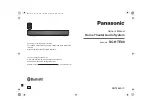
2
YOUR NEW SPEAKERS
Although CI Home Series in-wall/in-ceiling speakers sound great out of the carton,
they will sound even better once they are broken in. Operate them for several hours
before you listen critically.
High-frequency drivers use ferro-fluid that can thicken at temperatures below
10° C (50° F). If your speakers have been transported or stored in the cold, let them
warm to room temperature before use.
Clean speaker housing with a soft, damp cloth. Do not use a strong or abrasive
cleaner or get any part of the speaker wet.
HOW TO AVOID SPEAKER DAMAGE
Use an appropriate amplifier. At high volumes, a very powerful amplifier can
overdrive your speakers and damage them. On the other hand, if your amplifier isn’t
powerful enough, it can produce clipping distortion that can easily damage high-
frequency drivers. (See your dealer.)
Don’t be fooled by your amplifier’s volume control. It adjusts listening level—it
does not indicate power output. If your speakers begin to sound harsh or grating,
or if you hear the bass breaking up, turn the volume down immediately or you
will damage your speakers! This type of damage constitutes abuse and is not
covered by warranty!
Tone controls and equalizers can demand even more power from an amplifier,
lowering the point at which it produces clipping distortion. Use them sparingly,
if at all, and do not use them when listening at loud levels.
YOUR LISTENING ROOM
The CI Home Series in-wall/in-ceiling speakers are suitable for use in a wide variety
of listening environments. Note however, that room construction, dimensions and
furnishings will all play a part in the quality of sound you ultimately achieve. The
extra care taken in installation will result in greater listening enjoyment. Try to
follow these guidelines:
a) Strong, rigid walls and ceilings are preferred for best bass balance. For
even better results, add cross-braces at about 12˝ (30 cm) above and below
(either side) the speaker to further increase rigidity.
b) Midrange and high frequencies are affected by room furnishings. For best
sound, your listening room should contain an average amount of curtains,
carpets, sofas, etc.
SPEAKER ASSEMBLY PARTS LIST
(one speaker)
• 1 in-wall/in-ceiling speaker complete with attached mounting clamps
and screws
• 1 mounting template




































